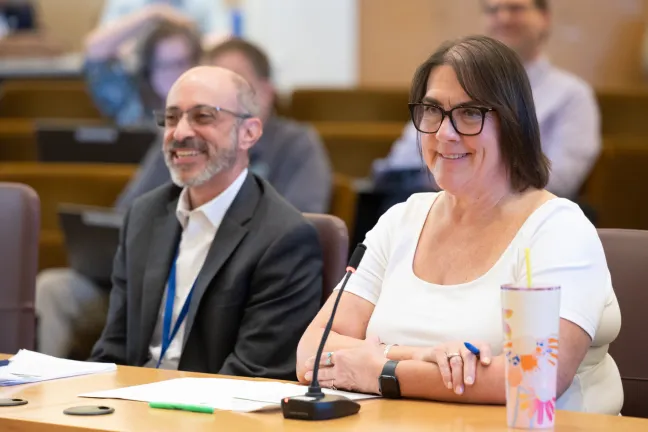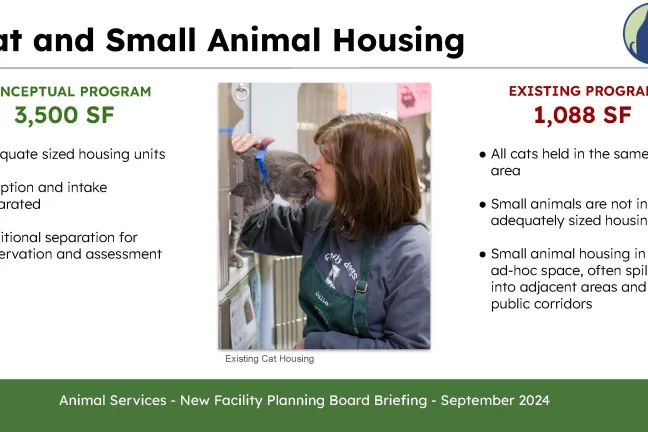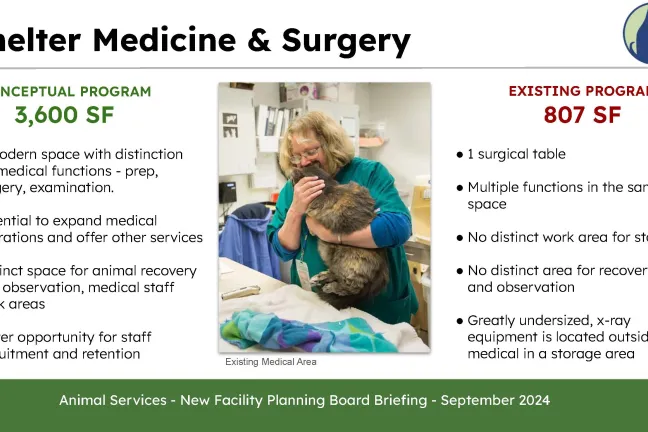New Shelter Dreams
The current animal shelter was built 50 years ago, when the County’s population was just 562,640. But as the County grew to 815,428 individuals –– a nearly 45% increase— the community’s needs outstripped the shelter’s capacity. Animal sheltering practices have also changed significantly since the 1970s. While the number of animals the shelter receives each year has actually decreased, their standard of care and individual length of stay has steadily increased. The shelter has gone from a live release rate of 20% in the early 1980s to 90% today. Recent increases in animal intake since 2020 — particularly for large dogs have also strained the shelter’s capacity during peak seasons. Overall, the current shelter space is inadequate to meet current animal care standards.
The proposed new animal shelter’s extended capacity and modern facility will not only address the adequate space needed for the growing animal and human population and current intake trends, but will also serve the community for generations to come.
The County has aspired to build a new Animal Services facility for a long time. The initial planning report for a new facility was produced in 2007. Animal Services has maintained a “Shelter Dreams” capital campaign donation fund for a new shelter for many years. 2016 proceeds from the sale of surrounding county land to McMenamins Edgefield campus were also restricted for future capital improvements. Beginning in 2019, local firm Carleton Hart Architecture collaborated with Animal Arts architecture design firm, consulting with Animal Services leaders, staff, and volunteers to produce a conceptual facility plan based on community needs and animal welfare best practices.
Board Briefing Summary
At the Sept. 24, 2024 Board Briefing, Director Grahek shared the challenges of the current shelter space to meet current guidelines set by the Association of Shelter Veterinarians, how it presents barriers to many of the goals and plans Animal Services has for the pets in its care, and the need for a facility design and location to provide equitable and accessible services to the community.
“Our current environment is one of our greatest challenges,” she said.
Facilities Director Zalkow shared about what a new shelter might include, in terms of square footage and programming needs. The conceptual design developed by Animal Arts would offer approximately 35,000 square feet, a nearly 100% increase from the current shelter space. Estimated costs for the facility are between $53 million and $65 million. Chair Jessica Vega Pederson clarified that projected budgets for a future facility don’t include the purchase of land. Director Zalkow indicated that funding strategies and locations for a new facility are to be determined.Board remarks
Overall, County Commissioners were supportive of the work of Animal Services and the process of continuing to explore the possibilities of a new shelter – where it could be located, how it would be funded, and what the design would be.
“Today helps us kick off this process of discovery, inquiry and moving toward these next steps,” said Chair Vega Pederson about the preliminary planning stage for a new facility. She expressed the need for a thoughtful process that considers the welfare of the animals and well being of any neighbors of a future facility and its potential impacts.
Commissioner Sharon Meieran briefly expressed her support for the audit findings on the condition of the animal services facilities – that the facility wasn’t formally evaluated in 2016 because the need for replacement was well-known – and for points and requests made by Commissioners Brim-Edwards and Lori Stegmann.
Commissioner Julia Brim-Edwards initiated the current planning process and quarterly briefings in a 2025 Budget Note request, and will be working with Chair Vega Pederson and Commissioner Stegmann for the project. Commissioner Brim-Edwards expressed her support for the new facility, and requested details on the ASV Guidelines pertaining to sheltering facilities, future animal population projections, and an advisory group of experts from a cross-section of animal welfare and shelter design specialties to inform the facility planning process.
Commissioner Stegmann requested information about potential future locations, and suggested that Multnomah County adopt an economies of scale approach by inviting other regional animal services agencies to collaborate in the planning process to help improve sheltering facilities in Multnomah County and in neighboring jurisdictions. She also expressed an idea to incorporate a “cat cafe” to help promote a comfortable and welcoming environment for adopters and visitors at the new facility.



